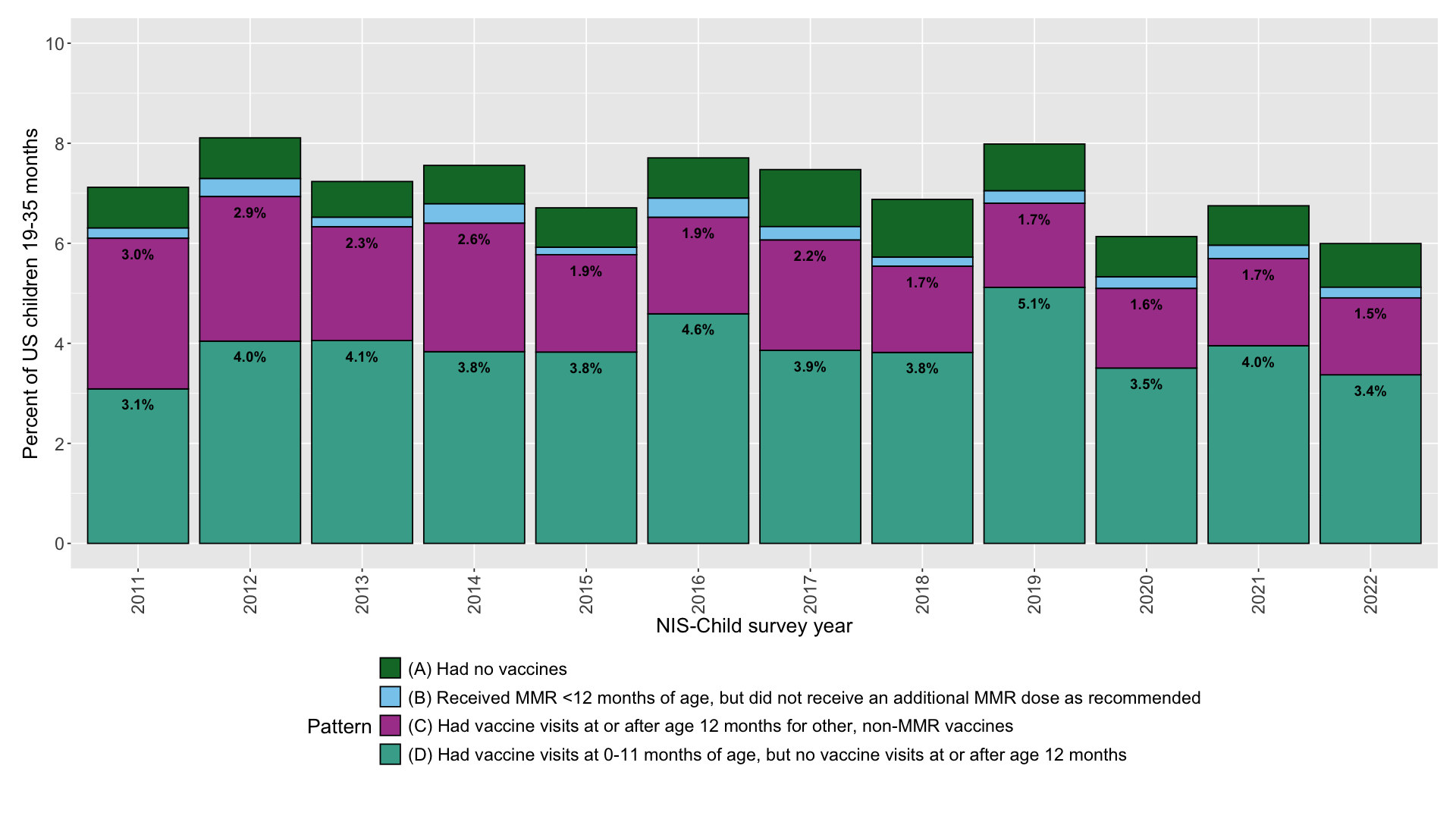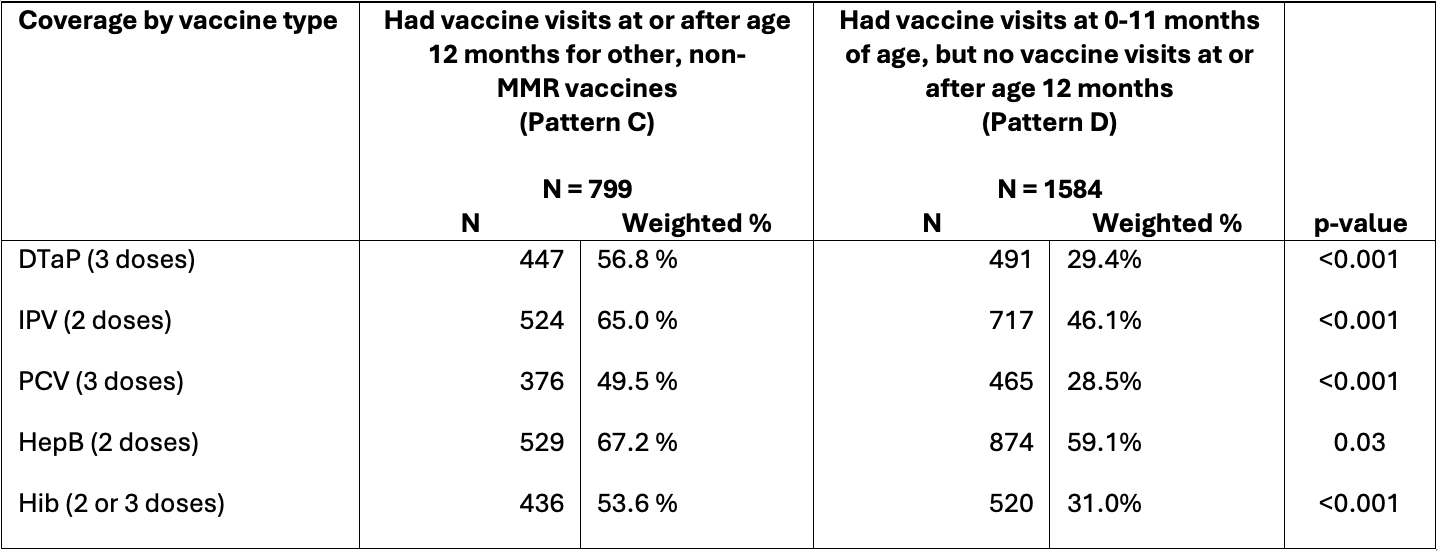Immunizations/Delivery 2
Session: Immunizations/Delivery 2
680 - Characteristics and Vaccination Patterns of U.S. Children Who Did Not Receive Routine Measles-Mumps-Rubella Vaccination, National Immunization Survey-Child, 2011-2022
Friday, April 25, 2025
5:30pm - 7:45pm HST
Publication Number: 680.4200
Sophia R. Newcomer, University of Montana Center for Population Health Research, Missoula, MT, United States; Erika Fox, University of Montana, Missoula, MT, United States; Alexandria N. Albers, University of Montana, Missoula, MT, United States; Sarah Y. Michels, University of Montana, Missoula, MT, United States; Christina L. Clarke, Kaiser Permanente Institute for Health Research, Aurora, CO, United States; Jason Glanz, kaiser Permanente, Institute for Health Research, Aurora, CO, United States; Matthew Daley, Kaiser Permanente Colorado, Aurora, CO, United States

Alexandria N. Albers, MPH, MS (she/her/hers)
Graduate Research Assistant
University of Montana
Missoula, Montana, United States
Presenting Author(s)
Background: Measles-mumps-rubella (MMR) vaccination is recommended at ages 12-15 months, and maintaining high coverage is essential for preventing outbreaks of these diseases.
Objective: To describe characteristics, including vaccination patterns, of children who did not receive MMR vaccination by ages 19-35 months.
Design/Methods: Using 2011-2022 National Immunization Survey-Child data, we analyzed trends in non-receipt of MMR vaccination. We quantified the percentage of children that (A) had no vaccines (i.e., were completely unvaccinated), (B) received MMR < 12 months of age, but did not receive an additional MMR dose as recommended, (C) had vaccine visits at or after age 12 months for other, non-MMR vaccines, and (D) had vaccine visits at 0-11 months of age, but no vaccine visits at or after age 12 months. Focusing on recent years (2020-2022), we used multivariable logistic regression to identify factors associated with not receiving MMR despite having other vaccinations after the 1st birthday, implying refusal of MMR (pattern C). We also compared coverage of other vaccines between MMR-unvaccinated children who did and did not have other vaccines on or after age 12 months. Analyses accounted for the complex survey design, including weighting for nationally-representative estimates.
Results: N=196,386 children had provider-verified vaccination records; 7.1% (95% CI: 6.9%-7.4%) did not receive MMR on or after their 1st birthday. Among these MMR-unvaccinated children, 12.1% had not received any vaccines, 3.6% received an early MMR dose that was not repeated, 29.4% had ≥ 1 immunization visit after age 12 months, and 54.9% initiated vaccines but did not have any vaccine visits at or after age 12 months. Overall, the percentage of children unvaccinated for MMR with an immunization visit after their 1st birthday (pattern C) decreased from 3.0% in 2011 to 1.5% in 2022 (Figure 1). In multivariable analyses, receipt of Women, Infants and Children (WIC) nutrition benefits was associated with lower odds of not having received MMR despite having other vaccinations at or after age 12 months (aOR: 0.63, 95% CI: 0.41-0.99, Table 1). MMR-unvaccinated children without an immunization visit after the 1st birthday were less likely to be up-to-date for other vaccines than MMR-unvaccinated children with visits after their 1st birthday (Table 2).
Conclusion(s): Many U.S. children unvaccinated against MMR also do not have other vaccinations in the second year of life. Efforts to increase MMR vaccination should include outreach to families whose children are falling behind on vaccinations or may have lost contact with primary care.
Figure 1: Measles-mumps-rubella (MMR) vaccination coverage and categories of nonreceipt of MMR vaccination at or after age 12 months by survey year, NIS-Child, 2011-2022
 Figure 1 caption: Categories of nonreceipt of MMR vaccination. A four-day grace period was applied for identifying MMR vaccination on or after the 1st birthday. When assessing whether a child had other vaccination visits on or after their 1st birthday, we considered any visits where a vaccination other than only influenza was given on or after age 361 days.
Figure 1 caption: Categories of nonreceipt of MMR vaccination. A four-day grace period was applied for identifying MMR vaccination on or after the 1st birthday. When assessing whether a child had other vaccination visits on or after their 1st birthday, we considered any visits where a vaccination other than only influenza was given on or after age 361 days. Table 1: Socioeconomic, demographic and immunization setting characteristics of MMR-unvaccinated children who had other vaccines at or after age 12 months (Pattern C) and who had initiated vaccines in ages 0-11 months but did not have any vaccines at or after age 12 months (Pattern D), National Immunization Survey-Child 2020-2022
.png) Table 1 caption: When assessing whether a child had other vaccination visits on or after their 1st birthday, we considered any visits where a vaccination other than only influenza was given on or after age 361 days (to allow for a four-day grace period during which vaccines recommended starting at 12 months of age can be given). P-values were calculated via Rao-Scott chi-square tests for categorical variables and weighted t-tests for the continuous variable of income to poverty ratio. In the regression models, respondents in categories containing fewer than 10 respondents were not analyzed; those levels are indicated with ---. Therefore, the multivariable model included n=2,349 children. The final multivariable model does not include the poverty status variable due to collinearity concerns with income to poverty ratio; income to poverty ratio was preferred for the final model because imputed values for this variable were included in the National Immunization Survey-Child public-use files.
Table 1 caption: When assessing whether a child had other vaccination visits on or after their 1st birthday, we considered any visits where a vaccination other than only influenza was given on or after age 361 days (to allow for a four-day grace period during which vaccines recommended starting at 12 months of age can be given). P-values were calculated via Rao-Scott chi-square tests for categorical variables and weighted t-tests for the continuous variable of income to poverty ratio. In the regression models, respondents in categories containing fewer than 10 respondents were not analyzed; those levels are indicated with ---. Therefore, the multivariable model included n=2,349 children. The final multivariable model does not include the poverty status variable due to collinearity concerns with income to poverty ratio; income to poverty ratio was preferred for the final model because imputed values for this variable were included in the National Immunization Survey-Child public-use files.Table 2: Coverage for other routine vaccinations by the 1st birthday, among MMR-unvaccinated children who did and did not have immunization visits at or after age 12 months, National Immunization Survey-Child 2020-2022
 MMR=measles-mumps-rubella; DTaP=diphtheria-tetanus-acellular pertussis; IPV=inactivated poliovirus; PCV=pneumococcal conjugate; HepB=hepatitis B; Hib=Haemophilus influenzae type b. When assessing whether a child had other vaccination visits on or after their 1st birthday, we considered any visits where a vaccination other than only influenza was given on or after age 361 days (to allow for a 4 day grace period). P-values were calculated via Rao-Scott chi-square tests. Hib coverage was dependent upon manufacturing brand.
MMR=measles-mumps-rubella; DTaP=diphtheria-tetanus-acellular pertussis; IPV=inactivated poliovirus; PCV=pneumococcal conjugate; HepB=hepatitis B; Hib=Haemophilus influenzae type b. When assessing whether a child had other vaccination visits on or after their 1st birthday, we considered any visits where a vaccination other than only influenza was given on or after age 361 days (to allow for a 4 day grace period). P-values were calculated via Rao-Scott chi-square tests. Hib coverage was dependent upon manufacturing brand. 
